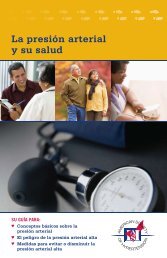2011 ASH Program Book - American Society of Hypertension
2011 ASH Program Book - American Society of Hypertension
2011 ASH Program Book - American Society of Hypertension
You also want an ePaper? Increase the reach of your titles
YUMPU automatically turns print PDFs into web optimized ePapers that Google loves.
amlodipine and sildenafil were used in combination, each agent independently<br />
exerted its own blood pressure lowering effect.<br />
Atorvastatin: Co-administration <strong>of</strong> multiple 10 mg doses <strong>of</strong> amlodipine with 80 mg<br />
<strong>of</strong> atorvastatin resulted in no significant change in the steady-state pharmaco -<br />
kinetic param eters <strong>of</strong> atorvastatin.<br />
Digoxin: Co-administration <strong>of</strong> amlodipine with digoxin did not change serum<br />
digoxin levels or digoxin renal clearance in normal volunteers.<br />
Ethanol (alcohol): Single and multiple 10 mg doses <strong>of</strong> amlodipine had no significant<br />
effect on the pharmacokinetics <strong>of</strong> ethanol.<br />
Warfarin: Co-administration <strong>of</strong> amlodipine with warfarin did not change the<br />
warfarin prothrombin response time.<br />
8 USE IN SPECIFIC POPULATIONS<br />
8.1 Pregnancy<br />
Pregnancy Category D [See Warnings and Precautions Section]<br />
The use <strong>of</strong> drugs that act directly on the renin-angiotensin-aldosterone system<br />
during the second and third trimesters <strong>of</strong> pregnancy can cause fetal and neo -<br />
natal morbidity and death. In addition, first trimester use <strong>of</strong> ACE inhibitors has<br />
been associated with birth defects in retrospective data. No animal studies were<br />
conducted with Tekamlo; however, decreased fetal birth weight was observed in<br />
animal studies with aliskiren and intrauterine deaths were observed in animal<br />
studies with amlodipine. Tekamlo can cause fetal harm when administered to a<br />
pregnant woman. When pregnancy is detected, discontinue Tekamlo as soon as<br />
possible. If Tekamlo is used during pregnancy, or if the patient becomes pregnant<br />
while taking this drug, the patient should be apprised <strong>of</strong> the potential hazard<br />
to the fetus.<br />
Human Data and Clinical Considerations<br />
Maternal hypertension is associated with increased risks for preterm delivery,<br />
intrauterine growth restriction, placental abruption, preeclampsia, and perinatal<br />
mortality. Appropriate management <strong>of</strong> maternal hypertension during pregnancy<br />
is important to optimize outcomes for both mother and fetus. Renin inhibitors<br />
(like aliskiren), angiotensin II receptor antagonists and angiotensin converting<br />
enzyme (ACE) inhibitors exert similar effects on the renin-angiotensin-aldosterone<br />
system. Based on several dozen published cases, ACE inhibitor use during the<br />
second and third trimesters <strong>of</strong> pregnancy is associated with fetal and neonatal<br />
injury, including hypotension, neonatal skull hypoplasia, anuria, reversible or<br />
irreversible renal failure, and death. Decreased fetal renal function may result in<br />
oligohydramnios and associated with fetal limb contractures, crani<strong>of</strong>acial deformation,<br />
and hypoplastic lung development. Prematurity, intrauterine growth<br />
retardation, and patent ductus arteriosus have been reported in women using<br />
these drugs, but it is not clear whether these occurrences were due to drug<br />
exposure. Limited data are conflicting about whether first trimester use <strong>of</strong> ACE<br />
inhibitors is associated with an increased risk <strong>of</strong> birth defects, but the drugs’<br />
mechanism <strong>of</strong> action raises a theoretical concern.<br />
When pregnancy occurs in a patient using Tekamlo, the physician should discontinue<br />
Tekamlo treatment as soon as possible. Inform the patient about potential<br />
risks to the fetus based on the time <strong>of</strong> gestational exposure to Tekamlo (first<br />
trimester only or later). If exposure occurs beyond the first trimester, perform an<br />
ultrasound examination.<br />
In rare cases when another antihypertensive agent cannot be used to treat the<br />
pregnant patient, serial ultrasound examinations should be used to assess the<br />
intraamniotic environment. Routine fetal testing with non-stress tests, biophysical<br />
pr<strong>of</strong>iles, and/or contraction stress tests may be appropriate based on gestational<br />
age and standards <strong>of</strong> care in the community. If oligohydramnios occurs in<br />
these situations, individualized decisions about continuing or discontinuing<br />
Tekamlo treatment and about pregnancy management should be made by the<br />
patient and her physicians. Patients and physicians should be aware that oligohydramnios<br />
may not appear until after the fetus has sustained irreversible injury.<br />
Infants exposed to Tekamlo in-utero should be closely observed for hypotension,<br />
oliguria, and hyperkalemia. If oliguria occurs, these infants may require blood<br />
pressure and renal perfusion support. Exchange transfusion or dialysis may be<br />
required to reverse hypotension and/or support decreased renal function.









